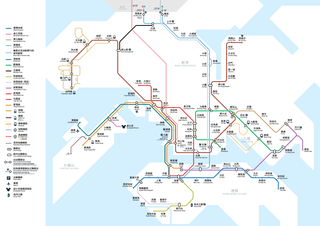Related Research Articles
Hong Kong counts approximately 600 temples, shrines and monasteries. While Buddhism and Christianity are the most widely practiced religions, most religions are represented in the Special Administrative Region.

Sau Mau Ping is an area part of Kwun Tong District, in eastern Kowloon, Hong Kong.

Auxiliary Medical Service (AMS) is a voluntary medical and health services provider in Hong Kong. Its mission is to supply effectively and efficiently regular services to maintain the health and well-being of people in Hong Kong.

Conduit Road is a road in the Mid-Levels on Hong Kong Island in Hong Kong.

Tin Shui Wai New Town is a satellite town in the northwestern New Territories of Hong Kong. Originally a gei wai (基圍) fish pond area, it was developed in the 1980s as the second new town in Yuen Long District and the eighth in Hong Kong. It is 25 kilometres (16 mi) due northwest of Central, the main business area in the territory, on land reclaimed from low-lying areas south of Deep Bay, next to Ping Shan. The population was 292,000 in 2014, while the total projected population for when the town is fully built-out is about 306,000.
The rainstorm warning signals are a set of signals used in Hong Kong to alert the public about the occurrence of heavy rain which is likely to bring about major disruptions such as traffic congestion and floods. They also ensure a state of readiness within the essential services to deal with emergencies.

Ma Yau Tong is an area on a mountain pass between Po Lam of Tseung Kwan O New Town and Sau Mau Ping of New Kowloon in Hong Kong. It is named after the village of the same name. It is known as Lau Tong and Ma Lau Tong in early 20th Century maps. Ma Yau Tong is on the border of New Kowloon and the New Territories.

Sau Mau Ping Estate is one of the earliest public housing estates in Kwun Tong District, New Kowloon, Hong Kong. It has 18 blocks, providing a total of 12,310 rental flats. Each of them has a size of 10.6 to 52.2 square metres. A total of 38,833 residents currently live in the 11,912 households on the Sau Mau Ping Estate.

Kotewall Road is a street in Mid-Levels, Hong Kong Island, Hong Kong, located between Po Shan Road and Robinson Road. It is a 400-metre-long two-way road located on hill slopes south of Sai Ying Pun.

KMB Route 1A is a bus route operated by Kowloon Motor Bus (KMB) in Hong Kong. It runs between Star Ferry and Sau Mau Ping (Central) and provides air-conditioned service. The route runs via Tsim Sha Tsui, Yau Ma Tei, Mong Kok, Kowloon City, San Po Kong, Ngau Tau Kok, Kwun Tong, and Sau Mau Ping.

Po Tat Estate, formerly called Po Lam Road Housing Development, is a public housing estate at the junction of Po Lam Road and Sau Mau Ping Road in Sau Mau Ping, Kwun Tong, Kowloon, Hong Kong, near Sau Mau Ping Estate and Tseung Kwan O Tunnel. It consists of 13 blocks and a shopping centre. In 2016, it housed a population of 24,642.

Tsui Ping Estate is a public housing estate in Kwun Tong, Kowloon, Hong Kong. It is divided into Tsui Ping (South) Estate and Tsui Ping (North) Estate. After redevelopment, the estate has a total of 19 blocks built in the 1980s and 1990s.

Sau Mau Ping Memorial Park is a park located in Sau Mau Ping, Kwun Tong District, Kowloon, Hong Kong. The park was built on the hillside between Tsui Ping Road, Hiu Kwong Street and Hiu Ming Street, in memorial to the deceased of the disastrous flooding on 18 June 1972, which took 71 lives when the hill slope adjacent to the park failed.

The East Kowloon line is a proposed Hong Kong rapid transit line that would run from Diamond Hill to Tseung Kwan O New Town. The route would pass through the hilly Sau Mau Ping residential area, which is not directly served by any local railway service at present. The scheme was first revealed by the Hong Kong Government in the "Railway Development Strategy 2014", published September 2014. The project is related to the government-led redevelopment of the East Kowloon area as well as planned residential development in the Anderson Road/Sau Mau Ping district.
The election for the Hong Kong deputies to the 10th National People's Congress (NPC) was held on 3 December 2002. 36 Hong Kong deputies were elected by an electoral college.
The June 2008 Hong Kong Rainstorm was a rainstorm in Hong Kong on 7 June 2008 that caused flooding and landslides. It resulted in 2 deaths and 16 injuries. The Hong Kong Observatory recorded 145.5mm of precipitation at its headquarters between 08:00 to 09:00, setting the 2nd highest one-hour precipitation record. A total of 307.1mm of precipitation was recorded during that day.
References
- 1 2 3 4 5 6 7 8 9 10 11 12 13 14 Yang; Mackey; Cumine (2008). FINAL REPORT OF THE COMMISSION OF INQUIRY INTO THE RAINSTORM DISASTERS 1972. Hong Kong: GEOTECHNICAL ENGINEERING OFFICE CIVIL ENGINEERING AND DEVELOPMENT DEPARTMENT THE GOVERNMENT OF THE HONG KONG SPECIAL ADMINISTRATIVE REGION.
- ↑ "THUNDERSTORM, RAINSTORM, FLOOD AND LANDSLIP WARNING SERVICES IN HONG KONG". www.hko.gov.hk. Retrieved 16 November 2015.
- 1 2 3 "Worst deluge in 83 years hits Hongkong". South China Morning Post. 19 June 1972. p. 1.
- ↑ Lee, E. Mark; Jones, David K. C. (1 January 2004). Landslide Risk Assessment. Thomas Telford. ISBN 9780727731715.
- 1 2 "H.K. rallies to aid victims: Rescuers working round the clock". South China Morning Post. 21 June 1972. p. 8.
- ↑ "1972 Po Shan Road landslide / Kotewall Road disaster | Gwulo: Old Hong Kong". gwulo.com. Retrieved 21 November 2015.